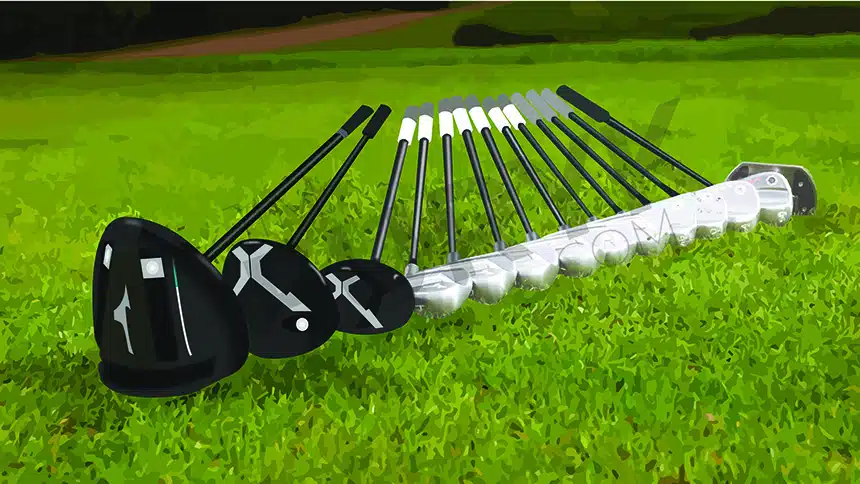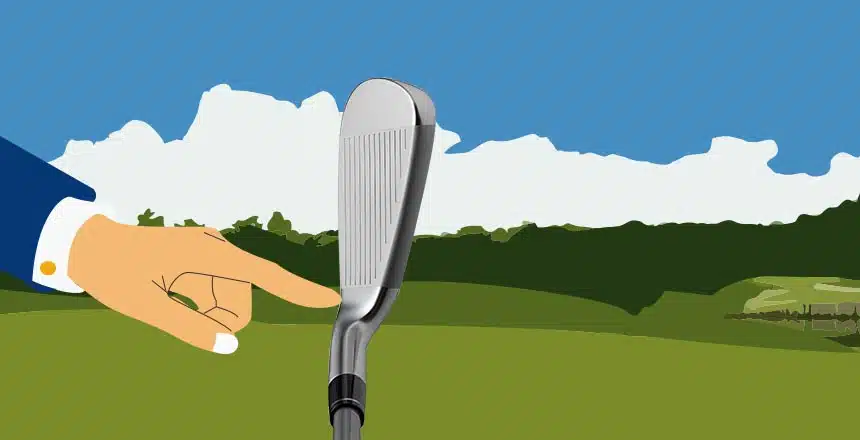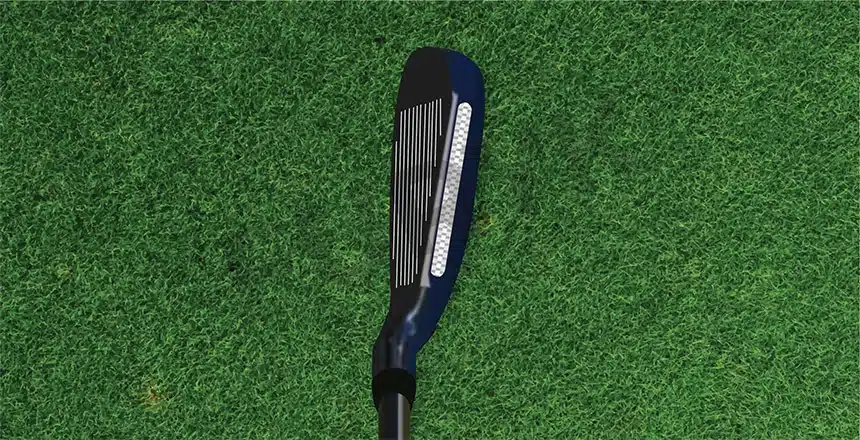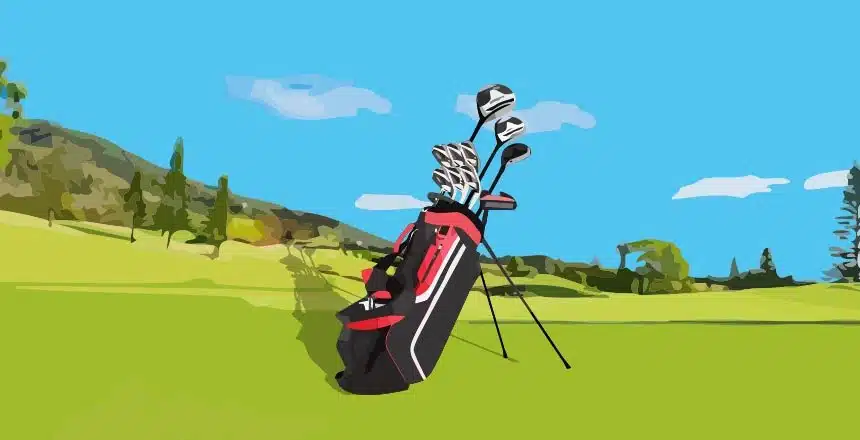You might already know that the degree loft of golf clubs varies. Top brands spend huge amounts of money every single year to make their clubs more and more advanced in terms of construction and performance. And this is largely due to the extensive manufacturing process, which includes deciding/designing the golf clubs’ loft angle.
To put it mildly, the loft is the angle between the clubface and the ground. And this loft angle is not the same throughout your whole golf club set.
Now let me state another commonly known fact – the loft is responsible for producing distance as well as trajectory and spin. And as you may already know, factors like spin, trajectory, and distance are very, very important in the game of golf.
So now let’s move on to getting to know more about what loft means and does, along with the different loft angles in golf clubs.
In This Post
Golf Club Loft Explained

The “loft” or “loft angle” refers to the angle of the clubface. It is the angle between the face of the club and a vertical plane.
It is expressed in degrees and indicates how much loft or lift the clubface will provide on impact with the golf ball.
The Loft is an important factor in determining the distance and trajectory of a golf shot. Lower lofted clubs, such as drivers, have less loft and provide a flatter trajectory, resulting in greater distance. Higher lofted clubs, such as wedges, have more loft and provide more lift, resulting in shorter shots that stop more quickly on the green.
The loft of a golf club is typically measured by a specialized machine known as a loft and lie machine. The machine clamps the golf club at the hosel and provides a reading of the angle of the clubface. The loft of a golf club can also be adjusted by bending the shaft, something that is commonly done to adjust the loft of drivers and fairway woods.
High Loft Vs. Low Loft Clubs
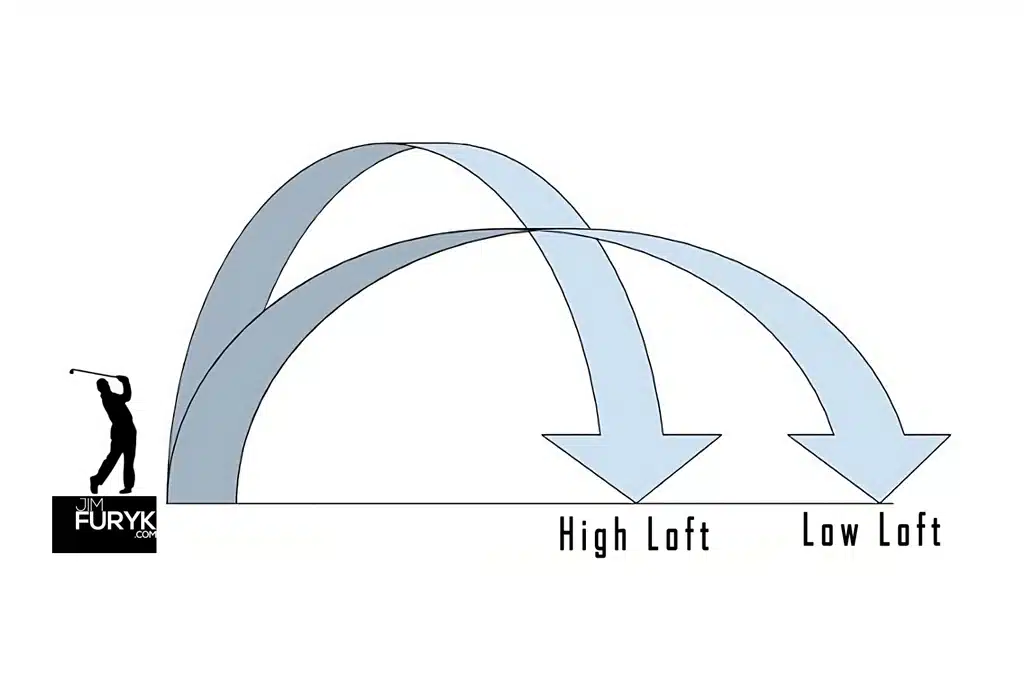
Golf Club with High Loft
A golf club that has a steep angle, known as high loft (as seen with the wedge in the image above), is designed to make sure that the golf ball doesn’t travel a great distance, but rather, it travels in a high arc. However, a high loft also minimizes the distance that the ball travels along the ground after landing, causing it to remain in close proximity to where it originally hit the ground.
When faced with certain conditions, a golf club that has a considerable inclination is appropriate.
A hindrance, like a bush or a tree, is preventing the ball from reaching the hole and must be surmounted. The golf ball is expected to have minimum rolling distance post landing, specifically while playing on the putting green where it must remain in place. A great height is necessary when hitting a shot from a bunker. The best club to use for this situation is a sand wedge.
Golf Club with Low Loft
Alternatively, utilizing a golf club with less loft (resulting in a decreased degree of golf club loft) produces a trajectory that is relatively level and covers a greater distance. Additionally, the player must keep in mind that when employing a club with less loft, the golf ball will roll a greater distance, causing it to land further away from its initial drop zone. Hence, it is not safe to presume that the ball will remain at rest where it touches down.
A golf club with a small angle of incline is appropriate for certain situations such as: The golf ball requires traveling a long way.
Upon landing, the golf ball is permitted to continue rolling and cover a longer distance. In golf, these situations usually happen either at the start of the game when using specific clubs like a driver, wood or hybrid, or when trying to hit the ball a long distance to reach the green, in which case a wood, hybrid or rescue club would be a wise choice.
Golf Club Loft Chart – What Is the Standard Loft On Golf Clubs?
Here’s a quick chart to compare golf club lofts.
| GOLF CLUB | STANDARD LOFT ANGLE |
|---|---|
| DRIVER | 9 – 12.5 degrees |
| 3-WOOD | 15 degrees |
| 4-WOOD | 17 degrees |
| 5-WOOD | 18-19 degrees |
| 7-WOOD | 21-22 degrees |
| 2-HYBRID | 17-18 degrees |
| 3-HYBRID | 19-20 degrees |
| 4-HYBRID | 21 – 23 degrees |
| 5-HYBRID | 24 – 26 degrees |
| 2-IRON | 16 – 19 degrees |
| 3-IRON | 21 degrees |
| 4-IRON | 24 degrees (19 degrees – stronger loft in a game improvement set) |
| 5-IRON | 27 degrees (21 degrees – stronger loft in a game improvement set) |
| 6-IRON | 30 degrees (25 degrees – stronger loft in a game improvement set) |
| 7-IRON | 34 degrees (28 degrees – stronger loft in a game improvement set) |
| 8-IRON | 38 degrees (32 degrees – stronger loft in a game improvement set) |
| 9-IRON | 42 degrees (38 degrees – stronger loft in a game improvement set) |
| PITCHING WEDGE | 46 degrees (43 degrees – stronger loft in a game improvement set) |
| GAP OR APPROACH WEDGE | 51 degrees (48 degrees – stronger loft in a game improvement set) |
| SAND WEDGE | 54 – 58 degrees |
| LOB WEDGE | 58 – 64 degrees |
Different Types of Golf Clubs and Their Loft Angles
1. Driver Loft Angle
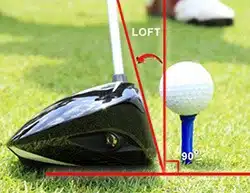
These longest golf clubs in every players’ bag have a standard loft between 9 degrees and 12.5 degrees. Shots with a golf driver are mostly struck using a slightly upward angle of attack because the golf ball here is usually teed up either 1.5 inches or higher. This results in extra “dynamic loft.”
Now if your swing speed is below average (under 90 mph) with a lower angle of attack (where you swing down slightly on the golf ball), then choosing a higher-lofted driver is a must – that is between 10.5 degrees and 12.5 degrees.
On the other hand, faster swingers in golf that can create additional dynamic loft through a positive angle of attack usually opt for lower-lofted drivers – that is between 8 degrees and 10.5 degrees.
Thanks to the latest tech, there are now drivers with adjustable loft too. You can actually adjust the loft angle by 1, 2, or 3 degrees. But then this will affect the open/closed position of the clubface at impact, along with the lie angle.
2. Fairway Wood Loft Angle
Wood lofts are generally lower in comparison to hybrids and irons, the driver being the lowest of course. So let’s cover every kind of fairway wood…
- 3-Wood Loft Angle
The standard 3-wood loft is approximately 15 degrees, although the range falls between 13.5 degrees and 16.5 degrees (the same as 2-iron).
Once again, players higher up on the ladder in golf opt for a lower loft. But if you can’t seem to launch the ball into the air easily, then picking a standard loft or even higher only makes sense.
Even 3-woods, just like drivers, are now manufactured with a loft that can be adjusted.
- 5-Wood Loft Angle
5-woods, for the most part, have a loft of either 18 degrees or 19 degrees. Although there are lower lofted (17.5 degrees) and higher lofted (19.5 degrees) 5-woods too.
The loft of a 3-iron is often between 5-wood and 7-wood. So if you end up hitting short and struggling with your long irons, a higher wood is the solution indeed. Even more experienced and skilled players prefer using 5-wood to improve ball flight as well as spin on those long approach shots.
The crucial choice between long iron and fairway wood also depends on weather and course conditions. For instance, when it’s windy, hitting a high-launch, high-spin wood instead of irons (on fast greens) is likely to send your shot offline.
- 7-Wood Loft Angle
Here the standard loft is 21 degrees but there are 22.5-degree 7-woods too.
Be it 7-wood or 5-wood, both are excellent alternatives to long irons. Certainly easier and more forgiving to hit for all types of golfers, 7-wood launches higher for a better ball flight.
You might also want to know that those who wish to ensure proper yardage gapping between 3-wood and 5-wood often prefer the 7-wood distance in place of 5-wood.
- Other Wood Loft Angles
The standard 2-wood loft is roughly 12 degrees and that of 4-wood is 17 degrees. Although these two fairway woods are rarely used and spotted at the PGA Tour level.
3. Hybrid Loft Angle
Hybrids are higher-lofted than woods, as are irons. So the loft of hybrids is much the same as that of irons that are similarly numbered. But the former i.e. hybrids are usually more forgiving and higher-launching (with more spin) than the latter, even though both share the same loft.
- 3-Hybrid Loft Angle
The standard loft of 3-hybrid is either 19 degrees or 20 degrees, the same as 3-irons and even those super game improvement 4-irons.
- 4-Hybrid Loft Angle
4-hybrids are typically lofted between 21 degrees and 23 degrees, which is lower than 4-irons.
However, it all depends on the manufacturer. Meaning if the 4-iron is specifically crafted for better players, then the hybrid loft is comparatively lower. On other hand, the loft of 4-hybrid and 4-iron is the same for mid-handicappers and beginners.
- 5-Hybrid Loft Angle
More often than not, the loft of a 5-hybrid is between 24 degrees and 26 degrees.
Now in comparison to 5-iron designed for more seasoned golfers, the 5-hybrid loft is and should be the same. But 5-hybrids have a significantly higher loft than extreme game improvement 5-irons.
- Other Hybrid Loft Angles
- 2-hybrid loft – 17 degrees.
- 6-hybrid loft – 27-28 degrees.
- 7-hybrid loft – 31 degrees.
Most beginners (meaning those with slower swing speeds) choose 6 and 7 hybrids. And not every brand even manufactures these higher hybrids.
4. Iron Loft Angle
Lower-numbered irons have a lower loft, just like woods.
Now, what does a stronger iron loft really mean? These are mainly engineered for beginners. And they now have a lower loft angle, even though the numbers on these irons have remained the same. Thanks to modern technology, manufacturers are now able to design irons that are higher launching and more forgiving than ever before.
This is why you mostly see high handicappers and beginners hitting stronger-lofted irons for producing optimal ball flight.
And yeah, one more thing you might want to know. The differences (in the loft) between players irons (for Tour-level golfers) and game improvement irons (for beginners and amateurs) are not the same with every brand. And these differences are often extreme.
- 1-Iron Loft Angle – The standard loft is typically between 14 degrees and 16 degrees. Although 1-irons are now practically non-existent.
- 2-Iron Loft Angle – The standard loft here is between 16 degrees and 19 degrees. Even 2-irons are not so common these days because most golfers prefer using a fairway wood, hybrid, or the fourth wedge instead of this outdated golf club.
- 3-Iron Loft Angle – The majority of 3-irons have a loft somewhere between 19 degrees and 21 degrees. Once again, fairway wood or hybrid is better than 3-iron.
- 4-Iron Loft Angle – 4-irons generally have a loft of 21-24 degrees. But if it’s a game improvement iron, then the loft angle can be lower i.e. 19 degrees.
- 5-Iron Loft Angle – The traditional loft of 5-iron is 26-27 degrees. Once again, just like 4-iron, even 5-iron in the game improvement category is lower lofted, that is 21 degrees.
- 6-Iron Loft Angle – These irons are aimed at better players, so the loft here is 30-31 degrees. But if it’s a beginner-friendly 6-iron, then a lower loft angle of 24 degrees is the norm.
- 7-Iron Loft Angle – If it’s a game improvement 7-iron, the standard loft is 28 degrees or lower. Otherwise, traditional 7-irons are lofted 34-35 degrees.
- 8-Iron Loft Angle – The standard loft is between 37 degrees and 39 degrees while the game improvement version is lower at 32 degrees.
- 9-Iron Loft Angle – Usually, more advanced golfers prefer the standard 9-iron loft angle, which is 41-43 degrees. As for beginners and even high handicappers, they perform better with game improvement irons. So this kind of 9-iron is lofted lower i.e. 37 degrees.
5. Wedge Loft Angle
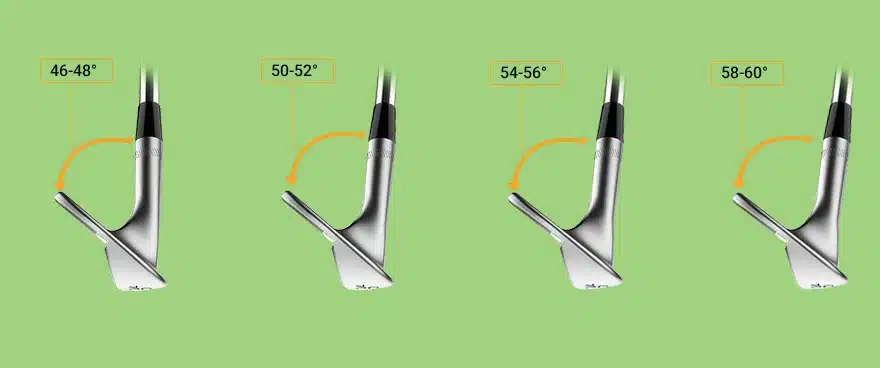
It’s actually very common to mess up wedge lofts. And that’s mainly because iron loft angles have been getting stronger (there are both pros and cons to that). So the result of this can be a little bit of confusion when it comes to the spacing between wedges and short irons.
But then that means all the more attention is required for choosing the proper set. Optimal yardage gaps or spacing between clubs is crucial if you want to touch average golf club distances, which inevitably leads to yielding greater shorter shots finishing closer to that hole.
With that in mind, let’s get to know all about the correct wedge loft angles…
Conventionally speaking, pitching wedge loft is 45-47 degrees. But you may want a lower-lofted PW (42-43 degrees) if you prefer game improvement technology.
This particular golf wedge’s standard loft is 52 degrees. And if it’s a part of a game improvement set of irons, then the loft angle is lower at 48 degrees.
The traditional loft of a sand wedge is 56 degrees. But you can pick a SW with a higher loft (58 degrees) or lower loft (54 degrees).
A standard LW is lofted at 60 degrees, although the range begins from 58 degrees to 64 degrees. If you struggle with the lob wedge, it’s better to choose a loft lower than 60 degrees.
And you should be able to ace your lob wedge shots since this club produces the highest launch angle, which is exactly what you need to get out of bunkers as well as to generate fast-stopping high shots on the green.
6. Putter Loft Angle
Needless to say, this golf club has the lowest loft angle. And the standard putter loft is 3-4 degrees.
How Do You Know the Right Loft Angle for You?
Knowing the right loft angle for your golf club can make a huge difference in your game. But how do you determine the correct loft angle for your swing? The answer is not always straightforward, as there are a variety of factors that come into play.
- Firstly, your swing speed is a critical factor in choosing the right loft angle. If you have a slower swing speed, you may want to consider a higher loft angle to maximize your carry distance. On the other hand, if you have a faster swing speed, a lower loft angle may be more appropriate to increase your distance.
- Secondly, the course you play may affect your choice of loft angle. If you play on a course with many bunkers and hazards, a higher loft angle may help you get the ball out of tricky lies more easily. However, if you frequently play on wide-open courses with few hazards, a lower loft angle might help you maximize distance and accuracy.
- Lastly, the type of shot you prefer to play should also be considered. If you like to hit high-flying shots, a higher loft angle will create more spin and lift, resulting in a higher trajectory. If you prefer to hit low, piercing shots, a lower loft angle will keep your ball trajectory lower and reduce the amount of spin.
Ultimately, the best way to determine your ideal loft angle is to get fitted by a professional. They can evaluate your swing, ball flight, and other factors to recommend the perfect loft angle for you. The right loft angle can make a significant difference, so taking the time to find the perfect club can be well worth it in the end. Lowering your ball trajectory and reducing the amount of spin is crucial for achieving greater distance and accuracy on the golf course. By selecting the appropriate loft angle, you can optimize your performance and make the most of your golf clubs. While there are general guidelines for selecting the right loft angle based on your swing speed and other factors, a professional fitting is the best way to ensure a perfect match. Don’t settle for subpar performance when a simple adjustment to your loft angle can make all the difference. Invest the time and effort to find the perfect club, and your game will thank you for it in the end.
Frequently Asked Questions About Golf Club Loft
What Are the Five Types of Lofts In Golf?
Based on the five categories of golf clubs – woods (this includes the driver), hybrids, irons, wedges, and putter.
What Golf Clubs Have 22, 25, 26, and 27 Degree Lofts?
- 27 degrees loft angle – 5-iron, although there are some woods and hybrids too with the same loft.
- 26 degrees loft angle – this is a 5-hybrid or 4-iron.
- 25 degrees loft angle – this also could be a 4-iron.
- 22 degrees loft angle – typically, a 5-wood is lofted between 20 degrees and 22 degrees.
What Is the Highest Loft On A Golf Club?
That would be the lob wedge, where the loft angle is between 58 – 64 degrees.
How Much Does 1 Degree of Loft Affect Distance?
Given that you’re at your maximum clubhead speed, just 1-degree change in the loft angle of a golf driver can affect your driving distance by 2-4 yards.
As for irons, the difference in distance between 8-iron (37-39 degrees) and 9-iron (41-43 degrees) is usually 10-15 yards.
Does A Higher Loft Reduce Slice?
More loft equals more backspin, which reduces the chances of slicing the golf ball.
Does Change In Loft Angle Affect Clubface Angle?
When the loft of your golf club is lowered, the clubface angle is bound to decrease too. But if you increase the loft, the clubface angle tends to open. No wonder now there are drivers, hybrids, and irons with loft adjustability.
The EndNote
Ultimately, the best way to determine your ideal loft angle is to get fitted by a professional. They can evaluate your swing, ball flight, and other factors to recommend the perfect loft angle for you. The right loft angle can make a significant difference, so taking the time to find the perfect club can be well worth it in the end. Lowering your ball trajectory and reducing the amount of spin is crucial for achieving greater distance and accuracy on the golf course. By selecting the appropriate loft angle, you can optimize your performance and make the most of your golf clubs. While there are general guidelines for selecting the right loft angle based on your swing speed and other factors, a professional fitting is the best way to ensure a perfect match. Don’t settle for subpar performance when a simple adjustment to your loft angle can make all the difference. Invest the time and effort to find the perfect club, and your game will thank you for it in the end.
References:

